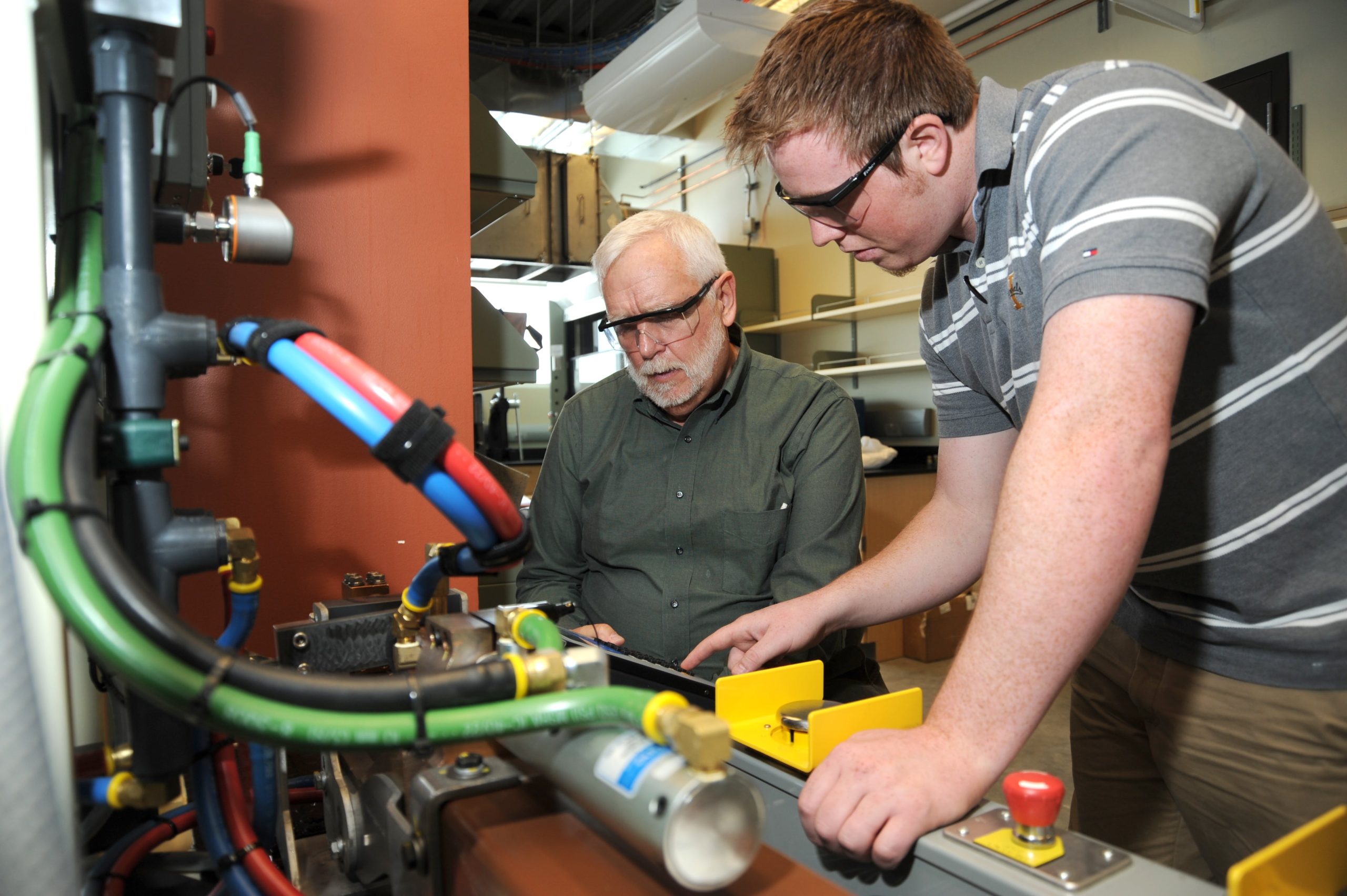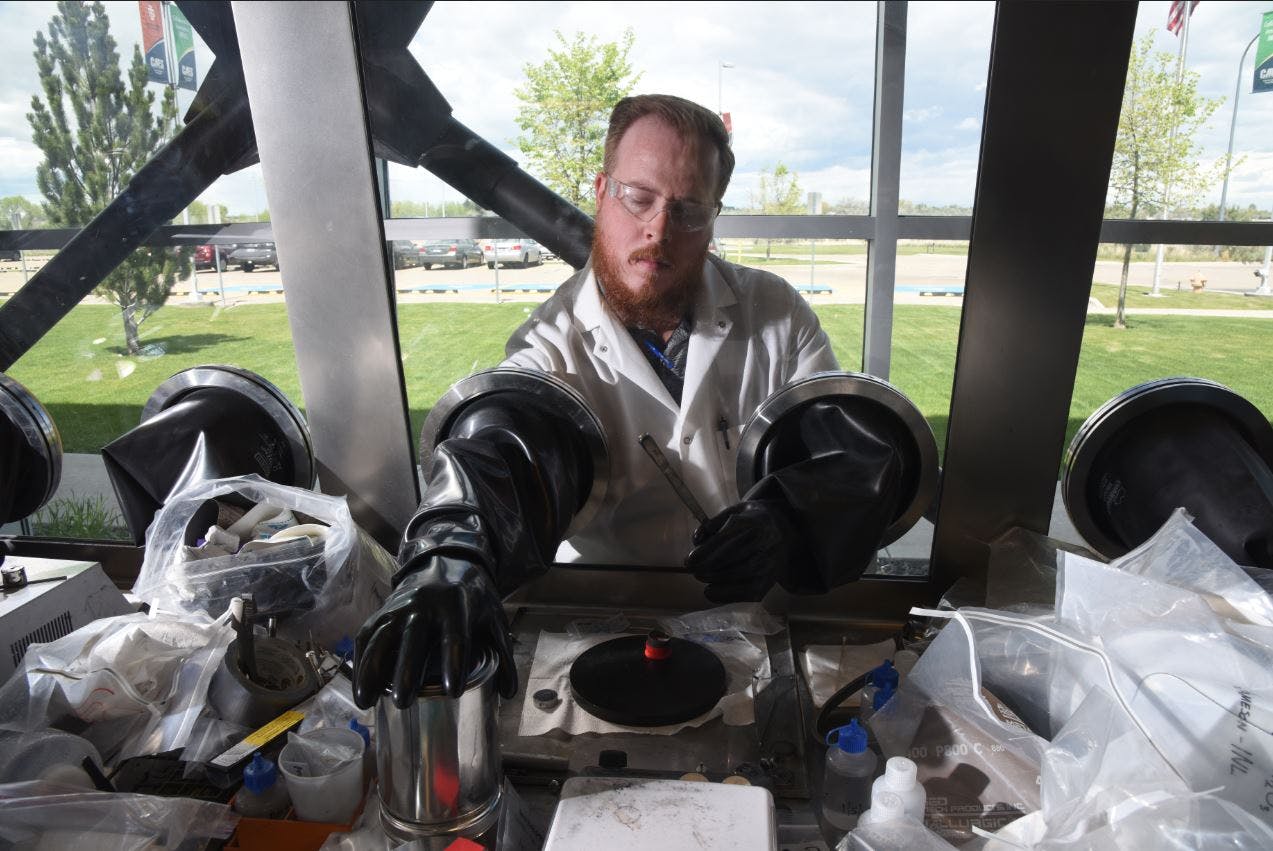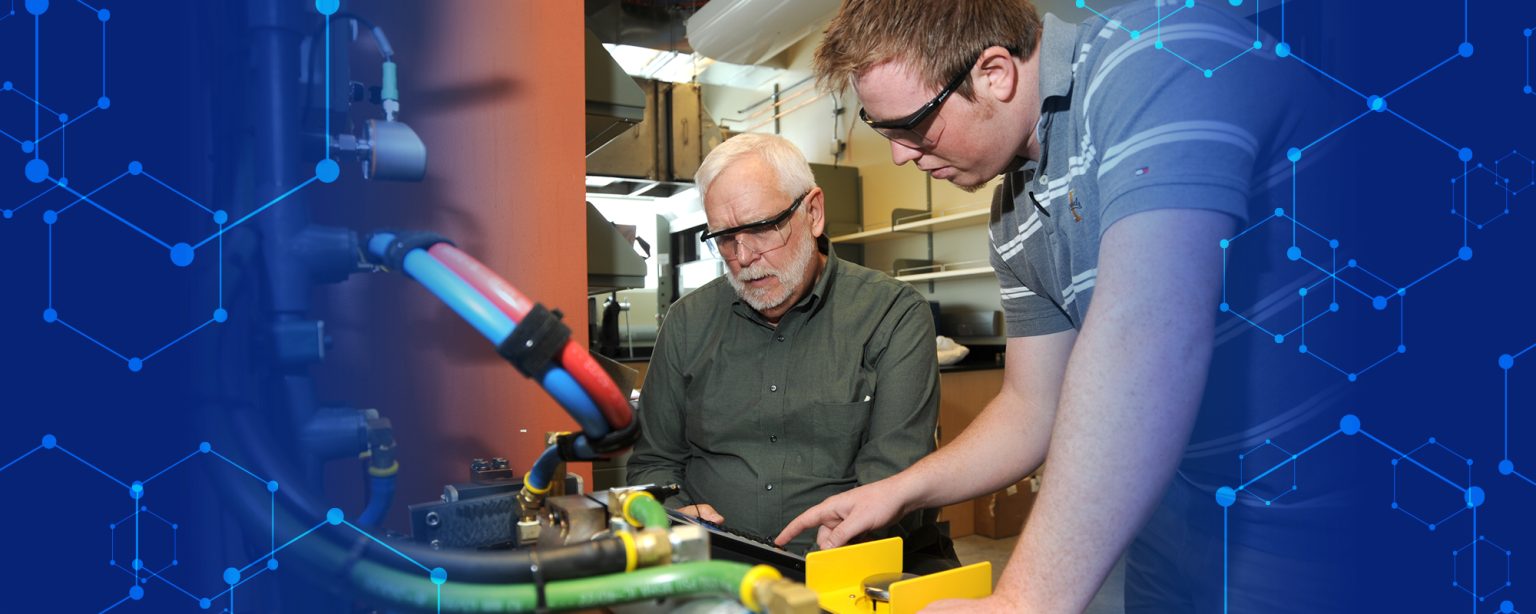Turnover is inherent in the design of the Center for Advanced Energy Studies (CAES). Students graduate, interns scatter and researchers complete their projects. Nathan Jerred is an exception.
Jerred has been a fixture at CAES since 2009, when he walked into the facility for the first time as an intern with the Center for Space Nuclear Research. Since then, he’s earned both his doctorate and master’s from the University of Idaho, served as a staff scientist for the Center for Space Nuclear Research, and had his research funded by NASA and the Laboratory Directed Research and Development program at Idaho National Laboratory (INL). Today, he’s a leader in the fuel development efforts underway at INL’s Materials and Fuels Complex to advance nuclear space propulsion.
Jerred has used almost every piece of equipment in the Advanced Materials Laboratory and learned how to wield the pressure resistance welder in the Catalysis and Kinetics Laboratory. He carried out the majority of the research for his Ph.D., which he received in May, in the Advanced Materials Laboratory and the Microscopy and Characterization Suite. Jerred has collaborated with, mentored and received support from fellow researchers at each of the CAES entities: INL, Boise State University, Idaho State University and the University of Idaho.
What is CAES?

When CAES was conceived in the mid-2000s, the idea was to demonstrate that government, academia and private industry could work together to produce a new generation of experts to address the world’s energy woes. This would be accomplished through collaboration, providing members with streamlined access to the resources and expertise at the national laboratory and the universities in the consortium. Students would benefit from the networks created between their professors and researchers, and the national lab would benefit from the pool of well-trained experts emerging from the workforce pipeline those networks created, helping the lab address not just energy challenges but also the “silver tsunami,” or looming glut of retirements among its aging workforce.
It’s almost as if those who came up with the idea for CAES had Jerred in mind. The South Dakota native had just graduated from the University of Idaho with a bachelor’s degree in engineering when he walked into CAES for the first day as an intern in 2009, a few months after the facility’s ribbon-cutting ceremony. Jerred spent 10 weeks at CAES that summer, working on a concept for a space-based nuclear reactor.
“I always had a fascination for space,” he said. “(But) I was not planning on a research career.”
His stint at CAES, on the heels of a nuclear materials class with professor Indrajit Charit his senior year, convinced him to pursue a master’s degree in nuclear engineering at University of Idaho’s Idaho Falls extension campus. The decision meant he would remain at CAES for graduate school.
Jerred’s research resumes
In spring 2010, Jerred resumed his space nuclear research through the Center for Space Nuclear Research’s Next Degree program, which allows students in pursuit of advanced degrees to conduct research part-time.
In fall 2011, after he earned his master’s, Jerred was hired as a staff scientist with the Center for Space Nuclear Research, a position he held until summer 2018, when he joined the Fuel Fabrication Division at the Materials and Fuels Complex. He had started his doctorate in materials science and engineering two years earlier, in fall 2016.
Until this spring, Jerred essentially worked two full-time jobs – 10-hour days at the Materials and Fuels Complex Monday through Wednesday or Thursday, and his graduate work research the rest of the week, including weekends.
“Nevertheless, Nathan has been successful in meeting these ambitious goals, aided by a strong work ethic and an unflappably calm demeanor, and driven by an intense curiosity,” said Patrick Hogan, manager of the Advanced Fuel Manufacturing and Development department. “He has proven unusually adept at learning, quickly establishing himself as a respected subject matter expert on everything he’s been exposed to.”
Jerred’s success is no surprise to those who know him

That mirrors Jerred’s reputation at CAES, according to Bryan Forsmann, who worked at CAES as a senior technician in the Advanced Materials Laboratory, where he helped Jerred with sample preparation and glove box work. Forsmann admired Jerred’s knack for learning complex new procedures, plus his ability to develop new procedures when needed and his willingness to mentor the young researchers in his midst.
“He’s really thoughtful … driven, motivated. He’s so well-rounded, always a resource to the other researchers,” said Forsmann, who is now operations coordinator in INL’s Nuclear Science and Technology directorate. “He spent so much time working with young researchers at CAES. He is a good human, a good father, a good student, a good researcher, a great mentor.”
Charit, the University of Idaho professor who helped spark Jerred’s interest in nuclear materials, said he is not surprised at the career trajectory of his former pupil.
“Once he moved to CAES after his bachelor’s degree, I knew that he would get further opportunities and exposure,” Charit said.
CAES’ role
Jerred is grateful for those opportunities, as well as the support he received from a slew of current and former colleagues, including Hogan at MFC and Forsmann and others at CAES, including Chief Safety Officer Kristi Moser-McIntire; Yaqiao Wu, the director and lab lead of the Microscopy and Characterization Suite; Megha Dubey, former instrument lead; and Mason Jaussi, a former safety officer at CAES.
Jerred also credits his former professor Charit with not only drawing his attention to the nuclear field but also with focusing his doctoral research on fuel fabrication. His advice to current students: Get involved with your undergraduate professors as much as possible. In Jerred’s experience, having a solid relationship with your professors as an undergraduate “pays off immensely” if you go on to graduate school.
“Put yourself out there,” Jerred said. “In most cases, professors need help on their research projects and are eager to have students involved. That exposure can help you figure out if you like research or not.”
He also advises students to persevere if they encounter adversity. He was not accepted to the Center for Space Nuclear Research fellowship program the first time he applied but did not let that dissuade him from applying again.
“A lot of internships are very competitive,” he said.
Next steps in Jerred’s research career
Jerred is moving on from CAES now, but in a way, his career has come full circle since his days as an intern. Today, he and his colleagues are focused on developing an advanced ceramic composite fuel for the NASA Space Nuclear Propulsion program. His formal education is complete, but every day he learns more about materials that he hopes could result in the development of a nuclear rocket propulsion system for the first manned mission to Mars.
“I’m getting this exposure to space nuclear again, which I really enjoy,” Jerred said. “It’s really fascinating stuff.”
Jerred may no longer be the exception at CAES. Though he stayed longer than most, he’s more like the rule, a testament to CAES and those who helped create it more than a decade ago.
“CAES as an avenue to INL and a research career, it still works,” he said. “I was able to take advantage of that and was able to earn my advanced degree as a result. Without it, that might not have been possible.”





